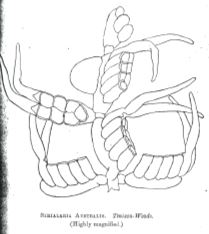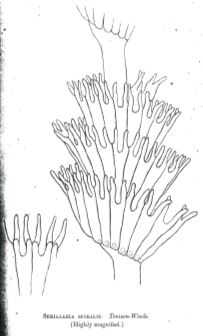page 83
On Some New Australian Polyzoa.
by the Rev. J. E. TENISON-WOODS, F.G.S., &c., Hon. Mem. Roy. Soc., N.S.W.
Read before the [Royal] Society [of N.S.W.] 4 July 1877
THE following two new species of SERIALARIA. belong to the family Vesiculariadoe (order INFUNDIBULATA, sub-order 3, CTENOSTOMATA.). It is now some years since I noticed the first, but had no opportunity to examine it until the year 1874, when by the aid of that experienced microscopist and scientific statist, Mr. W. H. Archer, F.L.S., &c., I was able to determine its character. I may say here that Mr. Archer made all the necessary investigations with the aid of his very extensive microscope apparatus, and the drawings were made by Mr. J. R. Y. Goldstein of Warnambool, under the direction of Mr. Archer.
SERIALARIA - Lamarck. Character:- Polypidom confervoid, horny, fistular, and branched. Cells, tubular, uniserial, and unilateral, disposed in close parallel companies in internodes at stated intervals. - Johnston, "Brit. Zoophytes," vol. i, p. 368.
SERIALARIA AUSTRALIS. sp. nov.
S. polyzoarium with the internodes completely occupied by seven to ten tubular cells, adnate to one another, perpendicular to the frond, curved, and lengthening towards the end of the series. Internodes serial, or giving off two others at right angles. Two long ligulate processes proceeding apparently from the terminal cell mouths of each internode. These are about twice the length of the internode. Mouth of cell somewhat crescentic, with a thickened margin.
Found after storms in masses amongst seaweed in Guichen Bay, South Australia. It is of light brown colour, and very like a mass of aphides. The transparent fistular branches, whence the cells arise, are corrugated and constricted at the internodes. In section they appear rhomboidal. Some of the cells seem to be provided with a conical cap. Are these ovicells?
This species is very close to S. lendigera, Lamarck, but it is much more stout and solid, the cells are in a double series and quite fill up each internode, while there are frequently long vacant spaces in the British species. The ligulate processes are double at the end of each internode, while they are often single and only occasional in S. lendigera. See Johnston, .Brit. Zooph., 1st edit. (1838), p. 251, fig. 40. In Ellis's Nat. Hist. of the
page 84
Corallines, Lond., 1755, at p. 27, we find the following notice of that species: - "Corallina exigua, caule geniculato, scandens, vesiculis ex unoquoque geniculo sic dispositis, ut syringam Panis referent. Fucoides Lendigerum capillamentis cuscutoe instar implexis. Nit Coralline. This extremely small climbing coralline arises from very minute tubes by which it adheres to fucuses and other marine bodies, and is so disposed from its jointed shape that it climbs up and runs over other corallines and fucuses as dodder does over other plants. The vesicles have the appearance of rows of denticles are placed in such a regular order on the end of each joint that when they are magnified they represent the antique figure of Pan's pipe. I have called it the Nit Coralline from Mr. Ray's calling it the Nit-bearing Fucoides. The small vesicles closely-jointed together in little speck-like figures among the irregular capillary branches gives us some idea of that form." I may add that the Australian species does not, as far as I am aware, climb over sea-weed as above described.
SERIALARIA SPIRALIS. sp. nov.
S. p. dichotomously branched with clusters of cells in series of twenty to twenty-four, disposed spirally round the axis of the branches. Cells flat, nearly four times as long as wide, each provided at the mouth with two divergent hollow spines half as long as the cell.
Common at various places on the southern coast of Australia and in Tasmania. The spiral disposition of the cells distinguishes this species from all others. In appearance it is like little masses of fine knotted fibre or a delicate moss. Under the microscope it seems at first like a series of little conical cups placed one within another, and surrounded with spines. It is not easy to trace the gradually ascending spiral series of cells, as the transparency blends their different parts into a confused mass The cells on the summits of the branches are usually incomplete and have their spines truncate and hollow. The clusters of the internodes form an easy receptacle for grains of sand, shell, an foraminifera, which also tends to confuse the aspect of the structure. Ovicells in large oval cups at the base of some of the spirals. Colour, dark brown.
It is to be remarked that neither of the above species polarises, whereas the calcareous polyzoa all show well defined peculiarities of structure under the polariscope. It would be an interesting inquiry to determine the nature of the substance which we call horny in these organisms.
Serialaria Australis. Tenison-Woods. (Highly magnified)

Serialaria Spiralis. Tenison-Woods. (Highly magnified).
